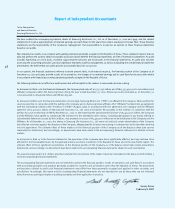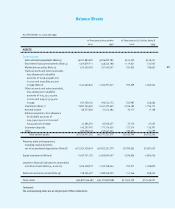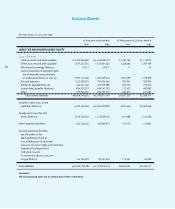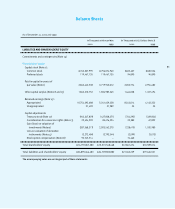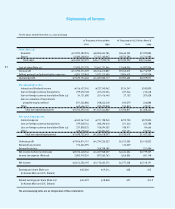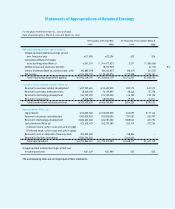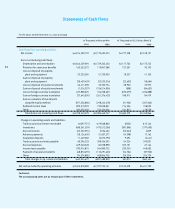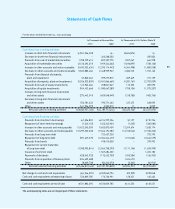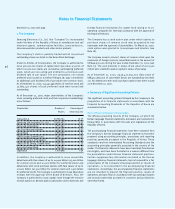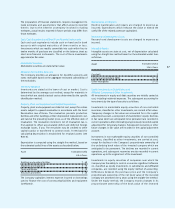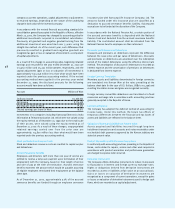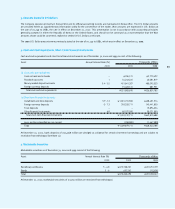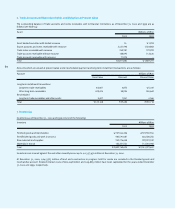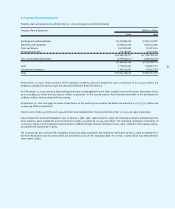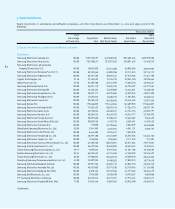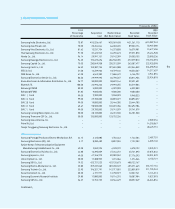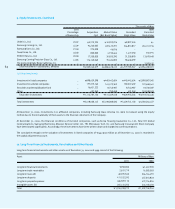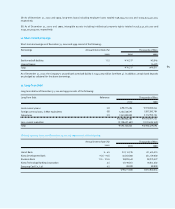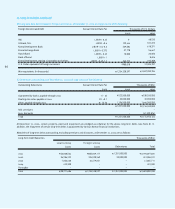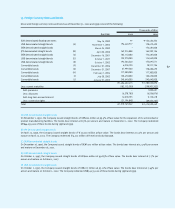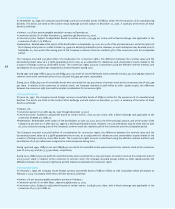Samsung 2000 Annual Report Download - page 58
Download and view the complete annual report
Please find page 58 of the 2000 Samsung annual report below. You can navigate through the pages in the report by either clicking on the pages listed below, or by using the keyword search tool below to find specific information within the annual report.
company as current operations, capital adjustments or adjustments
to retained earnings, depending on the nature of the underlying
change in book value of the invested company.
In accordance with the revised financial accounting standards for
consolidation generally accepted in the Republic of Korea, effective
March 23, 2000, the Company has changed its accounting policy for
additional investments acquired in consolidated subsidiaries.
Previously, all goodwill and negative goodwill arising from the
additional investment was amortized over 5 years using the
straight-line method. As of the current year, such differences that
previously resulted in goodwill and negative goodwill are
recognized as gain or loss on valuation of investment, a component
of capital adjustments.
As a result of this change in accounting policy, beginning retained
earnings and net profit for the year ended December 31, 2000 are
11,562 million and 5,332 million greater, respectively, and the
capital adjustment (gain or loss on valuation of investments) is
approximately 33,356 million less than what would have been
reported under the previous accounting method. If the revised
accounting method were applied to the previous year ended
December 31, 1999, the disclosed amounts for the following
accounts would have been as follows:
Investments in 6 companies including Samsung Electronics India
Information & Telecommunication Ltd. which were not valued using
the equity method as of December 31, 1999 due to the small scale
of their assets, were valued using the equity method as of
December 31, 2000. As a result of these changes, unappropriated
retained earnings carried over from the prior year are
approximately, 4,800 million less than what would have been
reported under the previous accounting method.
Stock and Debenture Issuance Costs
Stock and debenture issuance costs are credited to capital surplus
and debentures.
Accrued Severance Benefits
Employees and directors with more than one year of service are
entitled to receive a lump-sum payment upon termination of their
employment with the Company, based on their length of service
and rate of pay at the time of termination. Accrued severance
benefits represent the amount which would be payable assuming
all eligible employees terminated their employment at the balance
sheet date.
As of December 31, 2000, approximately 53% of the accrued
severance benefits are funded through an employee severance
insurance plan with Samsung Life Insurance Company, Ltd. The
amounts funded under this insurance plan are classified as a
deduction to accrued severance benefits liability. Subsequent
accruals are to be funded at the discretion of the Company.
In accordance with the National Pension Act, a certain portion of
the accrued severance benefits is deposited with the National
Pension Fund and deducted from the accrued severance benefits
liability. The contributed amount shall be refunded from the
National Pension Fund to employees on their retirement.
Discounts and Premiums on Debentures
Discounts and premiums on debentures represent the difference
between the issue price and par value of debentures. Discounts
and premiums on debentures are amortized over the redemption
period of the related debentures using the effective interest rate
method. The amortization of discount on debentures is recorded as
interest expense and the amortization of premiums on debentures
is deducted from interest expense.
Foreign Currency Translation
Monetary assets and liabilities denominated in foreign currencies
are translated into Korean Won at the rates prevailing at the
balance sheet date (in the case of U.S. Dollars, US$1 to 1,259) and
resulting translation losses and gains are recognized currently.
Foreign currency convertible debentures are translated at a fixed
conversion exchange rate in accordance with accounting practices
generally accepted in the Republic of Korea.
Income Tax Expense
The Company has adopted the deferred method of accounting for
income taxes. Under this method, the future tax effects of
temporary differences between the financial and tax bases of
assets and liabilities are reflected in the balance sheet.
Valuation of Assets and Liabilities at Present Value
Assets acquired and liabilities incurred through long-term
installment transactions and accounts and notes receivables under
rescheduled debt payments approved by the Korean judiciary are
stated at present value.
Product Warranties and Performance Guarantees
In conformity with accounting practices prevailing in the Republic of
Korea, costs related to repairs, service and other work required in
accordance with product warranties and performance guarantees
are charged to expense when incurred.
Derivative Instruments
The Company utilizes derivative instruments to reduce its exposure
to fluctuations in interest and foreign currency exchange rates.
Rights or obligations derived from derivative instruments are
recorded as assets or liabilities at fair value on an accrual basis.
Gains or losses on valuation of derivative instruments are
recognized as a component of current operations, except for gains
or losses on valuation of derivative instruments used to hedge cash
flows, which are recorded as a capital adjustment.
58
Account
Ordinary income
Net income
Earnings per share (in Won)
Diluted earnings per share (in Won)
Millions of Won
4,300,003
3,174,400
19,242
18,875


